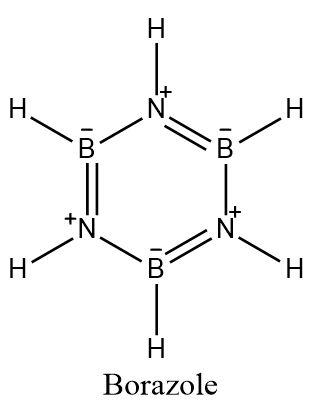Answer
393.3k+ views
Hint: Recollect the concept of bonding in boranes and their reactions. Boron will react with ammonia to form an intermediate which will decompose to give the final product. The final product might be similar to benzene.
Complete step by step answer:
-Boron is a non-metal having atomic number 5. Boron forms only covalent compounds. Boron hydride, $B{{H}_{3}}$ is quite stable in its dimeric form, also known as diborane, \[{{B}_{2}}{{H}_{6}}\].
-Diborane is a boron hydride formed by dimerization of two borane molecules. It is the most stable form of borane.
-Diborane is highly reactive when exposed to air and catches fire spontaneously.
-When diborane reacts with ammonia, an addition product that is, an adduct is formed when further decomposes on heating at 473K to form a volatile compound called borazine or borazole.
\[3{{B}_{2}}{{H}_{6}}+6N{{H}_{3}}\to 3{{\left[ B{{H}_{2}}{{\left( N{{H}_{3}} \right)}_{2}} \right]}^{+}}{{\left[ B{{H}_{4}} \right]}^{-}}\]
\[3{{\left[ B{{H}_{2}}{{\left( N{{H}_{3}} \right)}_{2}} \right]}^{+}}{{\left[ B{{H}_{4}} \right]}^{-}}\xrightarrow{473K}2{{B}_{3}}{{N}_{3}}{{H}_{6}}+12{{H}_{2}}\]
-Borazine is isostructural to benzene and hence, it is known as inorganic benzene.

-Borazole consists of alternate boron and nitrogen atoms having alternate single and double bonds. It has three double bonds and has $6\pi $ electron system which is similar to benzene.
-Borazine has the molecular formula, ${{B}_{3}}{{N}_{3}}{{H}_{6}}$.
So, the correct answer is “Option D”.
Additional Information:
In diborane, there is presence of two 3-centre-2-electron bonds also known as banana bonding. This banana bond is formed during dimerization of $B{{H}_{3}}$. 1s orbital of one hydrogen having one electron overlaps with one 2p orbital having one electron of one boron atom and one vacant 2p orbital of another boron atom to form this type of bonding.
Note: Revise the concept of boron. Remember diborane is stable due to banana bonding and borazine or borazole is isostructural with benzene.
Complete step by step answer:
-Boron is a non-metal having atomic number 5. Boron forms only covalent compounds. Boron hydride, $B{{H}_{3}}$ is quite stable in its dimeric form, also known as diborane, \[{{B}_{2}}{{H}_{6}}\].
-Diborane is a boron hydride formed by dimerization of two borane molecules. It is the most stable form of borane.
-Diborane is highly reactive when exposed to air and catches fire spontaneously.
-When diborane reacts with ammonia, an addition product that is, an adduct is formed when further decomposes on heating at 473K to form a volatile compound called borazine or borazole.
\[3{{B}_{2}}{{H}_{6}}+6N{{H}_{3}}\to 3{{\left[ B{{H}_{2}}{{\left( N{{H}_{3}} \right)}_{2}} \right]}^{+}}{{\left[ B{{H}_{4}} \right]}^{-}}\]
\[3{{\left[ B{{H}_{2}}{{\left( N{{H}_{3}} \right)}_{2}} \right]}^{+}}{{\left[ B{{H}_{4}} \right]}^{-}}\xrightarrow{473K}2{{B}_{3}}{{N}_{3}}{{H}_{6}}+12{{H}_{2}}\]
-Borazine is isostructural to benzene and hence, it is known as inorganic benzene.

-Borazole consists of alternate boron and nitrogen atoms having alternate single and double bonds. It has three double bonds and has $6\pi $ electron system which is similar to benzene.
-Borazine has the molecular formula, ${{B}_{3}}{{N}_{3}}{{H}_{6}}$.
So, the correct answer is “Option D”.
Additional Information:
In diborane, there is presence of two 3-centre-2-electron bonds also known as banana bonding. This banana bond is formed during dimerization of $B{{H}_{3}}$. 1s orbital of one hydrogen having one electron overlaps with one 2p orbital having one electron of one boron atom and one vacant 2p orbital of another boron atom to form this type of bonding.
Note: Revise the concept of boron. Remember diborane is stable due to banana bonding and borazine or borazole is isostructural with benzene.
Recently Updated Pages
Basicity of sulphurous acid and sulphuric acid are

Three beakers labelled as A B and C each containing 25 mL of water were taken A small amount of NaOH anhydrous CuSO4 and NaCl were added to the beakers A B and C respectively It was observed that there was an increase in the temperature of the solutions contained in beakers A and B whereas in case of beaker C the temperature of the solution falls Which one of the following statements isarecorrect i In beakers A and B exothermic process has occurred ii In beakers A and B endothermic process has occurred iii In beaker C exothermic process has occurred iv In beaker C endothermic process has occurred

What is the stopping potential when the metal with class 12 physics JEE_Main

The momentum of a photon is 2 times 10 16gm cmsec Its class 12 physics JEE_Main

How do you arrange NH4 + BF3 H2O C2H2 in increasing class 11 chemistry CBSE

Is H mCT and q mCT the same thing If so which is more class 11 chemistry CBSE

Trending doubts
Difference between Prokaryotic cell and Eukaryotic class 11 biology CBSE

Difference Between Plant Cell and Animal Cell

Select the word that is correctly spelled a Twelveth class 10 english CBSE

Fill the blanks with the suitable prepositions 1 The class 9 english CBSE

What is the z value for a 90 95 and 99 percent confidence class 11 maths CBSE

Give 10 examples for herbs , shrubs , climbers , creepers

What organs are located on the left side of your body class 11 biology CBSE

What is BLO What is the full form of BLO class 8 social science CBSE

Change the following sentences into negative and interrogative class 10 english CBSE



